ECON 3537: Evaluating Poverty Measures and their Global Implications
VerifiedAdded on 2023/06/15
|10
|2193
|56
Essay
AI Summary
This essay provides a critical evaluation of the existing measures of poverty in economics, analyzing their impacts on the overall economic growth of countries and the well-being of the population. It begins by defining poverty and its global implications, highlighting the shift from monetary deprivations to a more inclusive understanding encompassing healthcare, education, and employment. The essay then delves into different classifications of poverty, such as absolute and relative poverty, and examines various measures like the Headcount Index, Poverty Gap Index, and Squared Poverty Gap Index. It also discusses the Human Poverty Index (HPI) and its sub-measures, emphasizing their role in incorporating various aspects of deprivation to measure the real extent of poverty. The essay concludes that as the definitions of poverty become more inclusive, the measures have also evolved from single-dimensional to multi-dimensional, aiding policymakers in creating robust policies to address poverty.
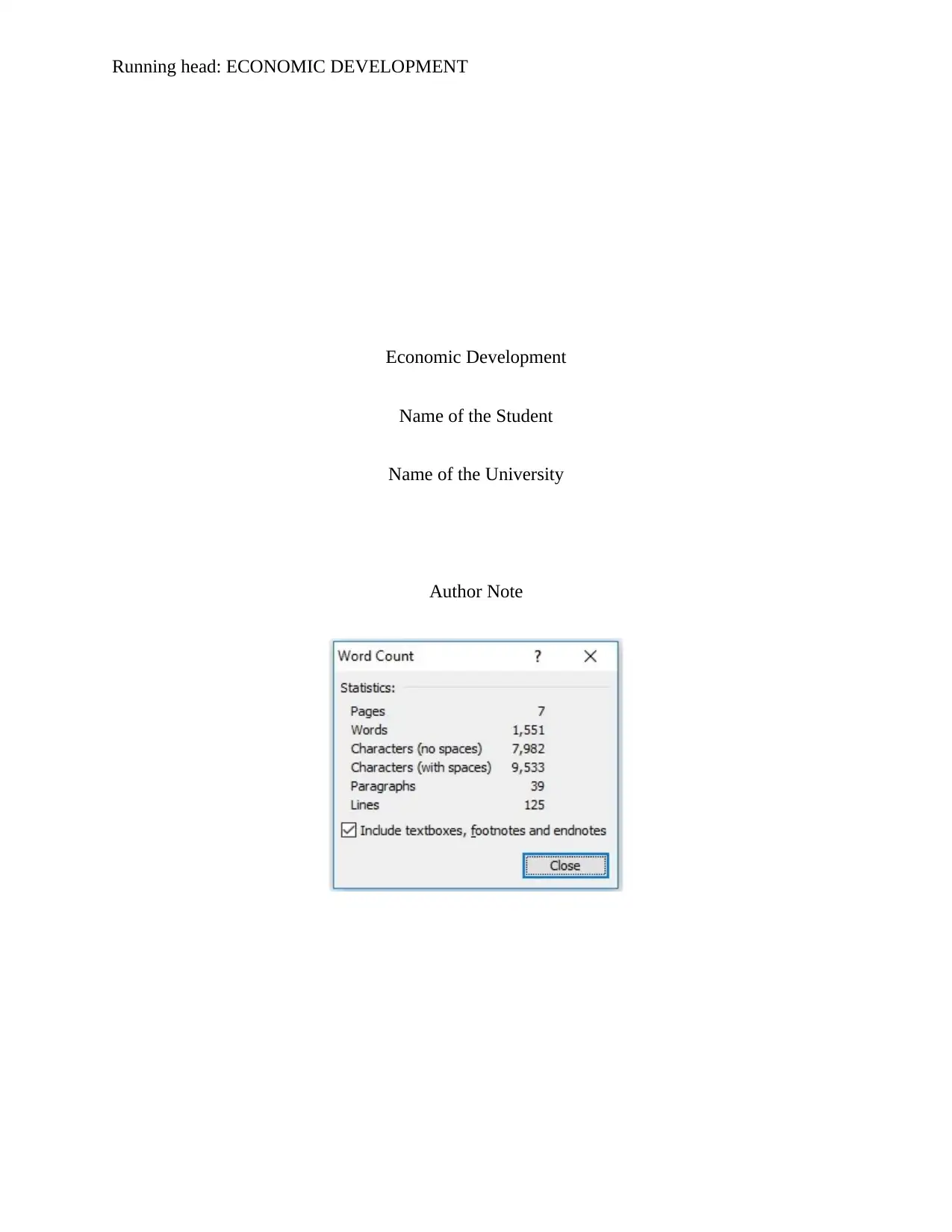
Running head: ECONOMIC DEVELOPMENT
Economic Development
Name of the Student
Name of the University
Author Note
Economic Development
Name of the Student
Name of the University
Author Note
Paraphrase This Document
Need a fresh take? Get an instant paraphrase of this document with our AI Paraphraser
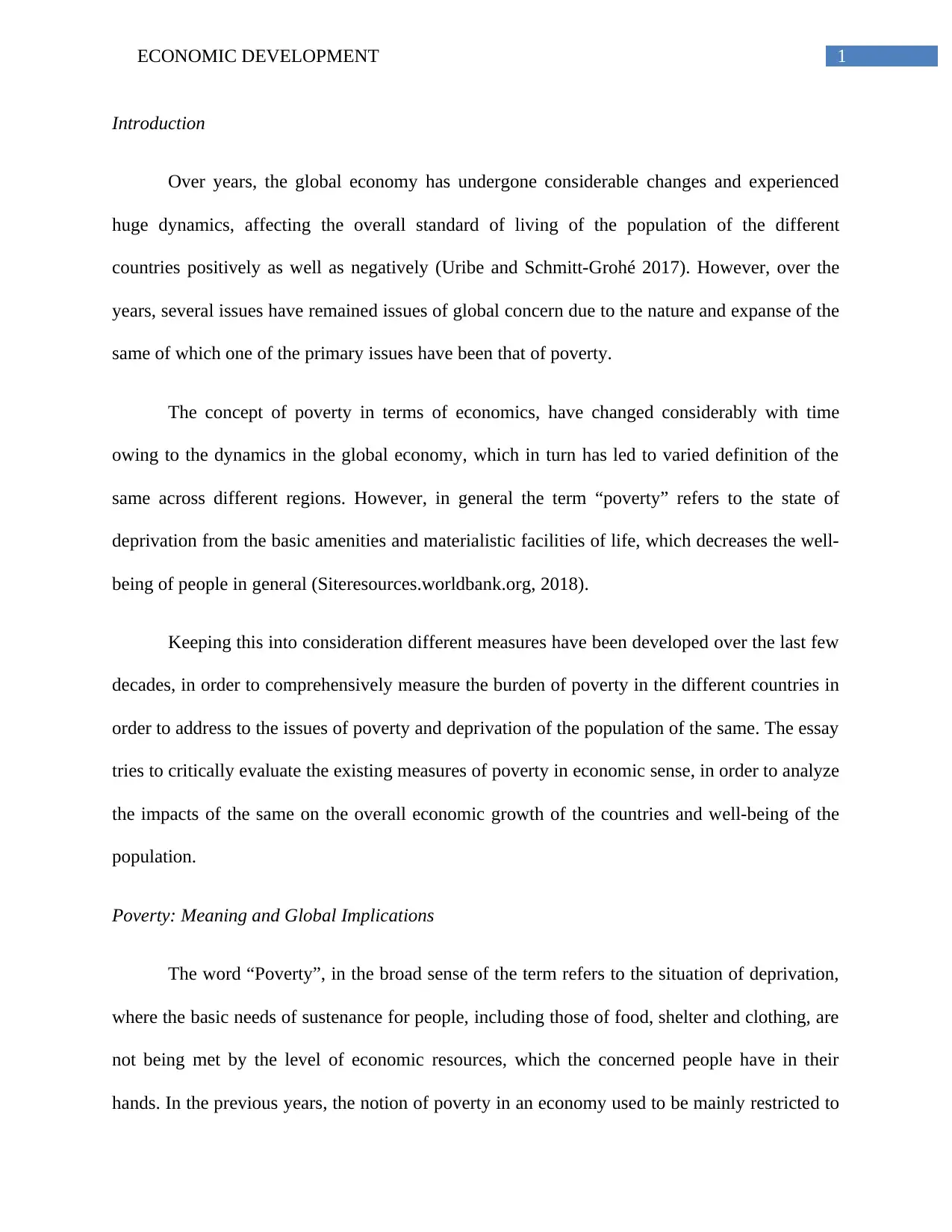
1ECONOMIC DEVELOPMENT
Introduction
Over years, the global economy has undergone considerable changes and experienced
huge dynamics, affecting the overall standard of living of the population of the different
countries positively as well as negatively (Uribe and Schmitt-Grohé 2017). However, over the
years, several issues have remained issues of global concern due to the nature and expanse of the
same of which one of the primary issues have been that of poverty.
The concept of poverty in terms of economics, have changed considerably with time
owing to the dynamics in the global economy, which in turn has led to varied definition of the
same across different regions. However, in general the term “poverty” refers to the state of
deprivation from the basic amenities and materialistic facilities of life, which decreases the well-
being of people in general (Siteresources.worldbank.org, 2018).
Keeping this into consideration different measures have been developed over the last few
decades, in order to comprehensively measure the burden of poverty in the different countries in
order to address to the issues of poverty and deprivation of the population of the same. The essay
tries to critically evaluate the existing measures of poverty in economic sense, in order to analyze
the impacts of the same on the overall economic growth of the countries and well-being of the
population.
Poverty: Meaning and Global Implications
The word “Poverty”, in the broad sense of the term refers to the situation of deprivation,
where the basic needs of sustenance for people, including those of food, shelter and clothing, are
not being met by the level of economic resources, which the concerned people have in their
hands. In the previous years, the notion of poverty in an economy used to be mainly restricted to
Introduction
Over years, the global economy has undergone considerable changes and experienced
huge dynamics, affecting the overall standard of living of the population of the different
countries positively as well as negatively (Uribe and Schmitt-Grohé 2017). However, over the
years, several issues have remained issues of global concern due to the nature and expanse of the
same of which one of the primary issues have been that of poverty.
The concept of poverty in terms of economics, have changed considerably with time
owing to the dynamics in the global economy, which in turn has led to varied definition of the
same across different regions. However, in general the term “poverty” refers to the state of
deprivation from the basic amenities and materialistic facilities of life, which decreases the well-
being of people in general (Siteresources.worldbank.org, 2018).
Keeping this into consideration different measures have been developed over the last few
decades, in order to comprehensively measure the burden of poverty in the different countries in
order to address to the issues of poverty and deprivation of the population of the same. The essay
tries to critically evaluate the existing measures of poverty in economic sense, in order to analyze
the impacts of the same on the overall economic growth of the countries and well-being of the
population.
Poverty: Meaning and Global Implications
The word “Poverty”, in the broad sense of the term refers to the situation of deprivation,
where the basic needs of sustenance for people, including those of food, shelter and clothing, are
not being met by the level of economic resources, which the concerned people have in their
hands. In the previous years, the notion of poverty in an economy used to be mainly restricted to
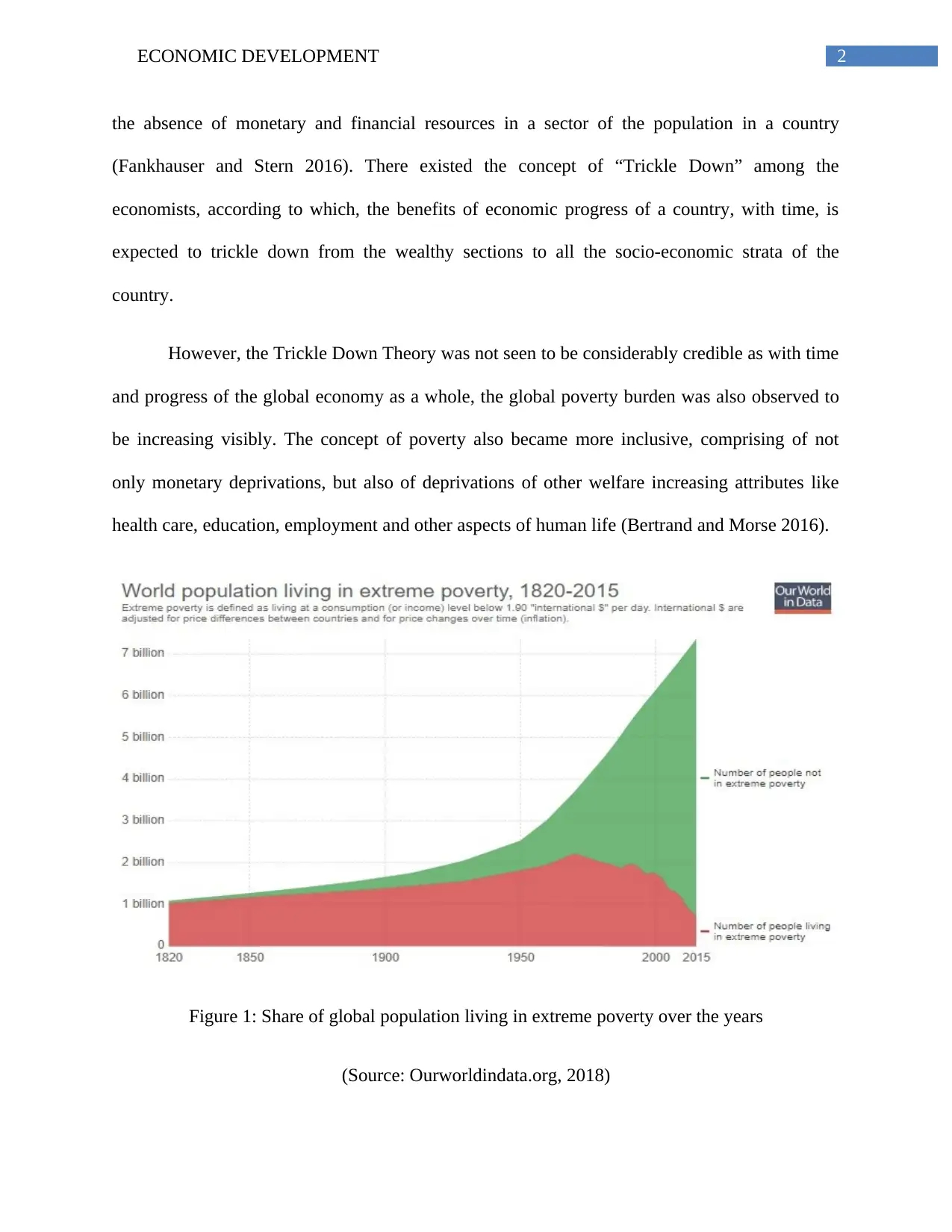
2ECONOMIC DEVELOPMENT
the absence of monetary and financial resources in a sector of the population in a country
(Fankhauser and Stern 2016). There existed the concept of “Trickle Down” among the
economists, according to which, the benefits of economic progress of a country, with time, is
expected to trickle down from the wealthy sections to all the socio-economic strata of the
country.
However, the Trickle Down Theory was not seen to be considerably credible as with time
and progress of the global economy as a whole, the global poverty burden was also observed to
be increasing visibly. The concept of poverty also became more inclusive, comprising of not
only monetary deprivations, but also of deprivations of other welfare increasing attributes like
health care, education, employment and other aspects of human life (Bertrand and Morse 2016).
Figure 1: Share of global population living in extreme poverty over the years
(Source: Ourworldindata.org, 2018)
the absence of monetary and financial resources in a sector of the population in a country
(Fankhauser and Stern 2016). There existed the concept of “Trickle Down” among the
economists, according to which, the benefits of economic progress of a country, with time, is
expected to trickle down from the wealthy sections to all the socio-economic strata of the
country.
However, the Trickle Down Theory was not seen to be considerably credible as with time
and progress of the global economy as a whole, the global poverty burden was also observed to
be increasing visibly. The concept of poverty also became more inclusive, comprising of not
only monetary deprivations, but also of deprivations of other welfare increasing attributes like
health care, education, employment and other aspects of human life (Bertrand and Morse 2016).
Figure 1: Share of global population living in extreme poverty over the years
(Source: Ourworldindata.org, 2018)
⊘ This is a preview!⊘
Do you want full access?
Subscribe today to unlock all pages.

Trusted by 1+ million students worldwide
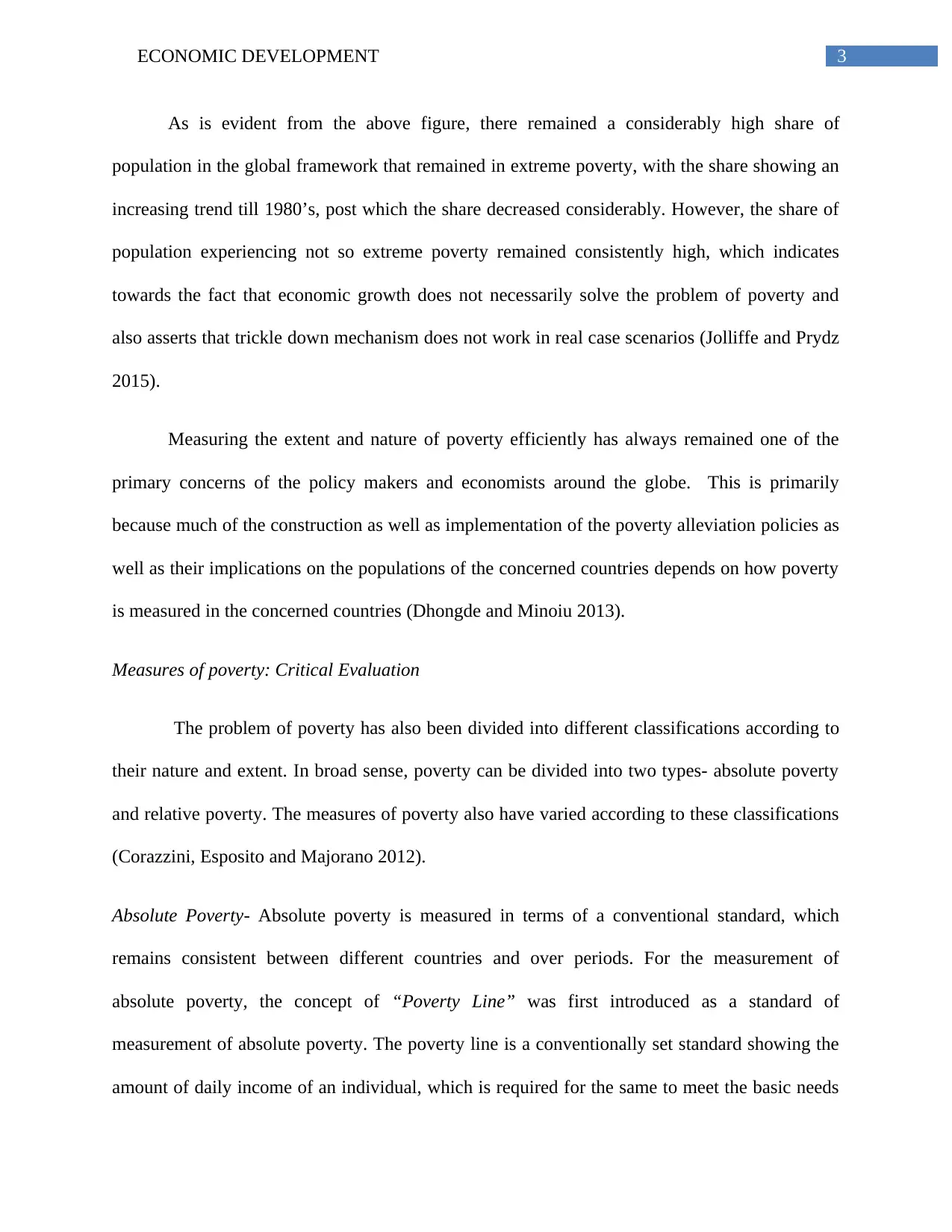
3ECONOMIC DEVELOPMENT
As is evident from the above figure, there remained a considerably high share of
population in the global framework that remained in extreme poverty, with the share showing an
increasing trend till 1980’s, post which the share decreased considerably. However, the share of
population experiencing not so extreme poverty remained consistently high, which indicates
towards the fact that economic growth does not necessarily solve the problem of poverty and
also asserts that trickle down mechanism does not work in real case scenarios (Jolliffe and Prydz
2015).
Measuring the extent and nature of poverty efficiently has always remained one of the
primary concerns of the policy makers and economists around the globe. This is primarily
because much of the construction as well as implementation of the poverty alleviation policies as
well as their implications on the populations of the concerned countries depends on how poverty
is measured in the concerned countries (Dhongde and Minoiu 2013).
Measures of poverty: Critical Evaluation
The problem of poverty has also been divided into different classifications according to
their nature and extent. In broad sense, poverty can be divided into two types- absolute poverty
and relative poverty. The measures of poverty also have varied according to these classifications
(Corazzini, Esposito and Majorano 2012).
Absolute Poverty- Absolute poverty is measured in terms of a conventional standard, which
remains consistent between different countries and over periods. For the measurement of
absolute poverty, the concept of “Poverty Line” was first introduced as a standard of
measurement of absolute poverty. The poverty line is a conventionally set standard showing the
amount of daily income of an individual, which is required for the same to meet the basic needs
As is evident from the above figure, there remained a considerably high share of
population in the global framework that remained in extreme poverty, with the share showing an
increasing trend till 1980’s, post which the share decreased considerably. However, the share of
population experiencing not so extreme poverty remained consistently high, which indicates
towards the fact that economic growth does not necessarily solve the problem of poverty and
also asserts that trickle down mechanism does not work in real case scenarios (Jolliffe and Prydz
2015).
Measuring the extent and nature of poverty efficiently has always remained one of the
primary concerns of the policy makers and economists around the globe. This is primarily
because much of the construction as well as implementation of the poverty alleviation policies as
well as their implications on the populations of the concerned countries depends on how poverty
is measured in the concerned countries (Dhongde and Minoiu 2013).
Measures of poverty: Critical Evaluation
The problem of poverty has also been divided into different classifications according to
their nature and extent. In broad sense, poverty can be divided into two types- absolute poverty
and relative poverty. The measures of poverty also have varied according to these classifications
(Corazzini, Esposito and Majorano 2012).
Absolute Poverty- Absolute poverty is measured in terms of a conventional standard, which
remains consistent between different countries and over periods. For the measurement of
absolute poverty, the concept of “Poverty Line” was first introduced as a standard of
measurement of absolute poverty. The poverty line is a conventionally set standard showing the
amount of daily income of an individual, which is required for the same to meet the basic needs
Paraphrase This Document
Need a fresh take? Get an instant paraphrase of this document with our AI Paraphraser
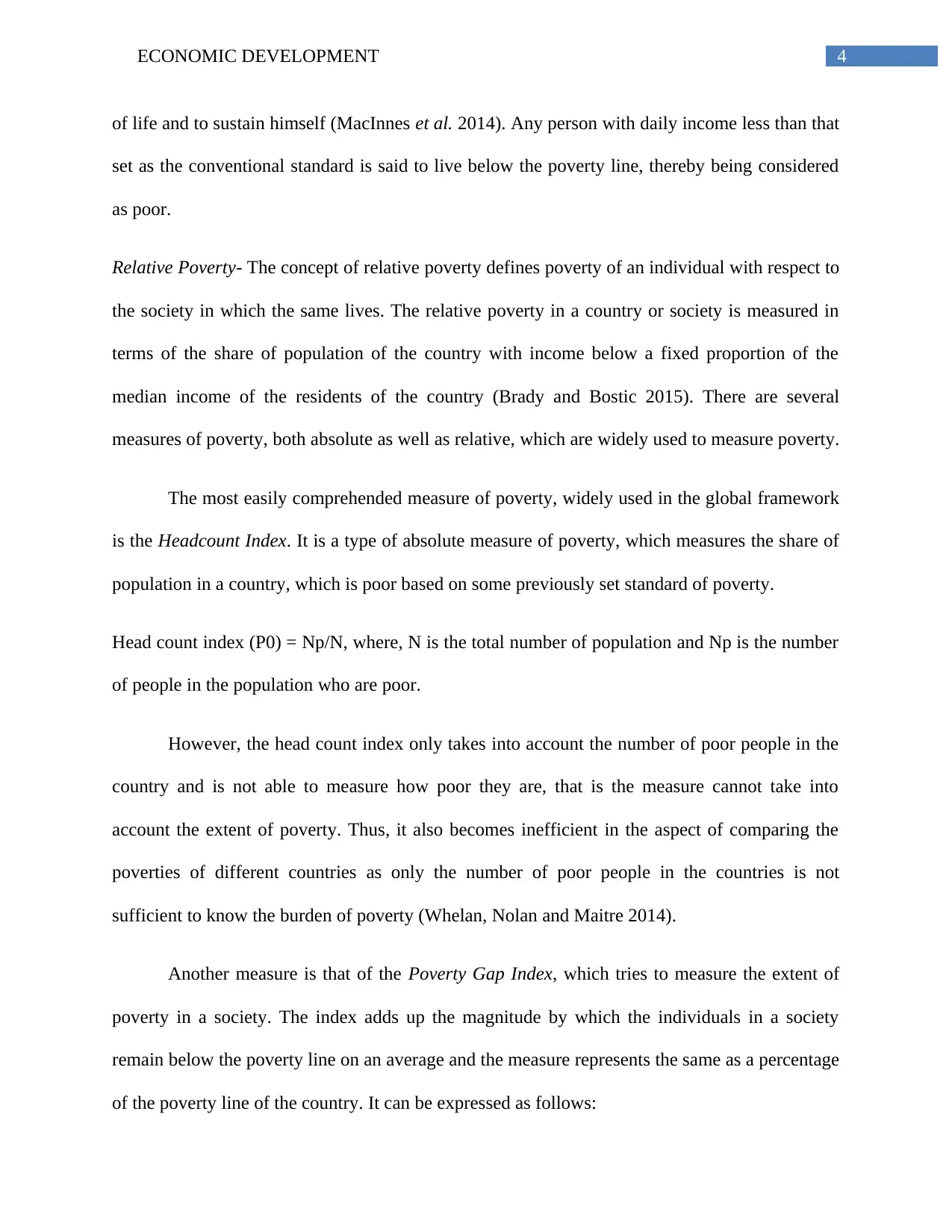
4ECONOMIC DEVELOPMENT
of life and to sustain himself (MacInnes et al. 2014). Any person with daily income less than that
set as the conventional standard is said to live below the poverty line, thereby being considered
as poor.
Relative Poverty- The concept of relative poverty defines poverty of an individual with respect to
the society in which the same lives. The relative poverty in a country or society is measured in
terms of the share of population of the country with income below a fixed proportion of the
median income of the residents of the country (Brady and Bostic 2015). There are several
measures of poverty, both absolute as well as relative, which are widely used to measure poverty.
The most easily comprehended measure of poverty, widely used in the global framework
is the Headcount Index. It is a type of absolute measure of poverty, which measures the share of
population in a country, which is poor based on some previously set standard of poverty.
Head count index (P0) = Np/N, where, N is the total number of population and Np is the number
of people in the population who are poor.
However, the head count index only takes into account the number of poor people in the
country and is not able to measure how poor they are, that is the measure cannot take into
account the extent of poverty. Thus, it also becomes inefficient in the aspect of comparing the
poverties of different countries as only the number of poor people in the countries is not
sufficient to know the burden of poverty (Whelan, Nolan and Maitre 2014).
Another measure is that of the Poverty Gap Index, which tries to measure the extent of
poverty in a society. The index adds up the magnitude by which the individuals in a society
remain below the poverty line on an average and the measure represents the same as a percentage
of the poverty line of the country. It can be expressed as follows:
of life and to sustain himself (MacInnes et al. 2014). Any person with daily income less than that
set as the conventional standard is said to live below the poverty line, thereby being considered
as poor.
Relative Poverty- The concept of relative poverty defines poverty of an individual with respect to
the society in which the same lives. The relative poverty in a country or society is measured in
terms of the share of population of the country with income below a fixed proportion of the
median income of the residents of the country (Brady and Bostic 2015). There are several
measures of poverty, both absolute as well as relative, which are widely used to measure poverty.
The most easily comprehended measure of poverty, widely used in the global framework
is the Headcount Index. It is a type of absolute measure of poverty, which measures the share of
population in a country, which is poor based on some previously set standard of poverty.
Head count index (P0) = Np/N, where, N is the total number of population and Np is the number
of people in the population who are poor.
However, the head count index only takes into account the number of poor people in the
country and is not able to measure how poor they are, that is the measure cannot take into
account the extent of poverty. Thus, it also becomes inefficient in the aspect of comparing the
poverties of different countries as only the number of poor people in the countries is not
sufficient to know the burden of poverty (Whelan, Nolan and Maitre 2014).
Another measure is that of the Poverty Gap Index, which tries to measure the extent of
poverty in a society. The index adds up the magnitude by which the individuals in a society
remain below the poverty line on an average and the measure represents the same as a percentage
of the poverty line of the country. It can be expressed as follows:
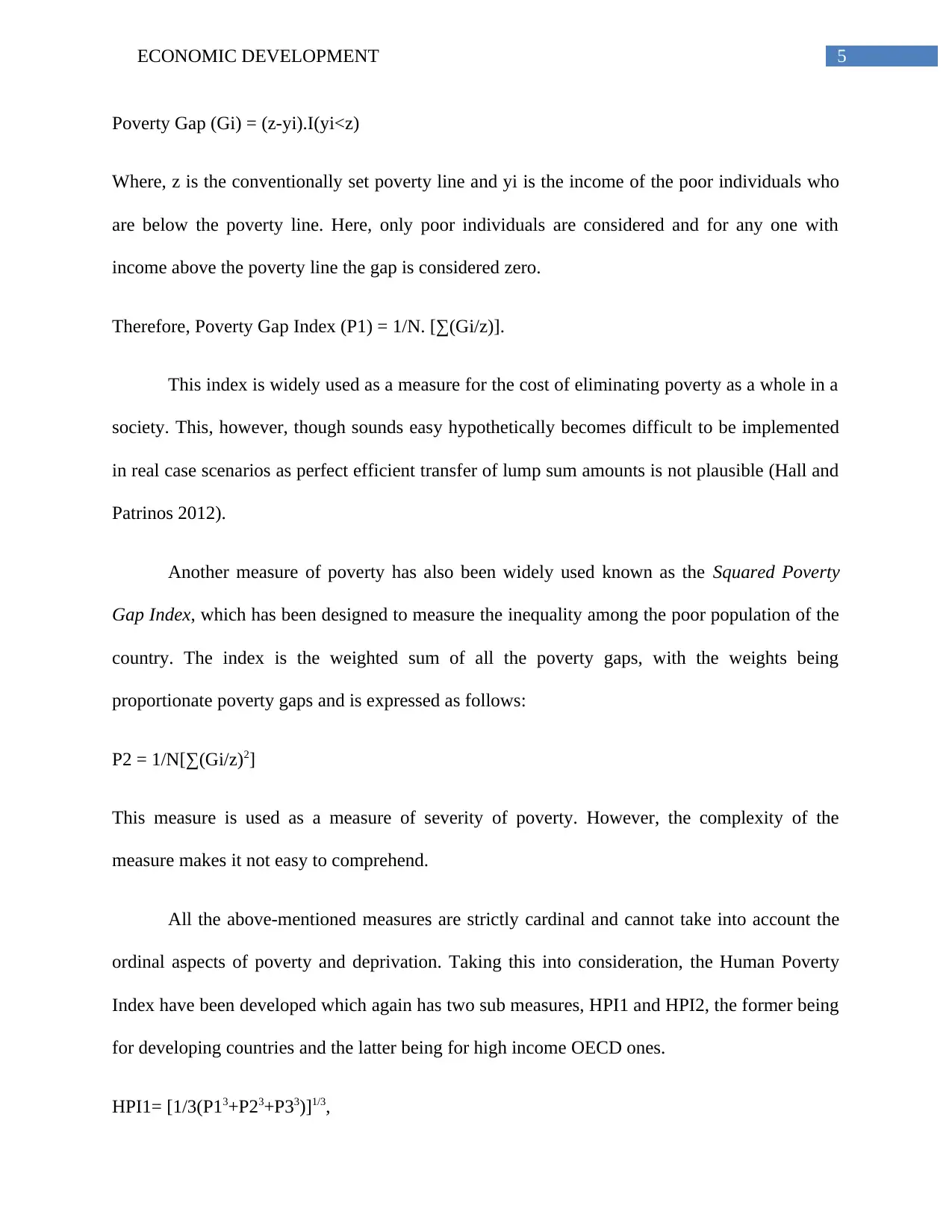
5ECONOMIC DEVELOPMENT
Poverty Gap (Gi) = (z-yi).I(yi<z)
Where, z is the conventionally set poverty line and yi is the income of the poor individuals who
are below the poverty line. Here, only poor individuals are considered and for any one with
income above the poverty line the gap is considered zero.
Therefore, Poverty Gap Index (P1) = 1/N. [∑(Gi/z)].
This index is widely used as a measure for the cost of eliminating poverty as a whole in a
society. This, however, though sounds easy hypothetically becomes difficult to be implemented
in real case scenarios as perfect efficient transfer of lump sum amounts is not plausible (Hall and
Patrinos 2012).
Another measure of poverty has also been widely used known as the Squared Poverty
Gap Index, which has been designed to measure the inequality among the poor population of the
country. The index is the weighted sum of all the poverty gaps, with the weights being
proportionate poverty gaps and is expressed as follows:
P2 = 1/N[∑(Gi/z)2]
This measure is used as a measure of severity of poverty. However, the complexity of the
measure makes it not easy to comprehend.
All the above-mentioned measures are strictly cardinal and cannot take into account the
ordinal aspects of poverty and deprivation. Taking this into consideration, the Human Poverty
Index have been developed which again has two sub measures, HPI1 and HPI2, the former being
for developing countries and the latter being for high income OECD ones.
HPI1= [1/3(P13+P23+P33)]1/3,
Poverty Gap (Gi) = (z-yi).I(yi<z)
Where, z is the conventionally set poverty line and yi is the income of the poor individuals who
are below the poverty line. Here, only poor individuals are considered and for any one with
income above the poverty line the gap is considered zero.
Therefore, Poverty Gap Index (P1) = 1/N. [∑(Gi/z)].
This index is widely used as a measure for the cost of eliminating poverty as a whole in a
society. This, however, though sounds easy hypothetically becomes difficult to be implemented
in real case scenarios as perfect efficient transfer of lump sum amounts is not plausible (Hall and
Patrinos 2012).
Another measure of poverty has also been widely used known as the Squared Poverty
Gap Index, which has been designed to measure the inequality among the poor population of the
country. The index is the weighted sum of all the poverty gaps, with the weights being
proportionate poverty gaps and is expressed as follows:
P2 = 1/N[∑(Gi/z)2]
This measure is used as a measure of severity of poverty. However, the complexity of the
measure makes it not easy to comprehend.
All the above-mentioned measures are strictly cardinal and cannot take into account the
ordinal aspects of poverty and deprivation. Taking this into consideration, the Human Poverty
Index have been developed which again has two sub measures, HPI1 and HPI2, the former being
for developing countries and the latter being for high income OECD ones.
HPI1= [1/3(P13+P23+P33)]1/3,
⊘ This is a preview!⊘
Do you want full access?
Subscribe today to unlock all pages.

Trusted by 1+ million students worldwide
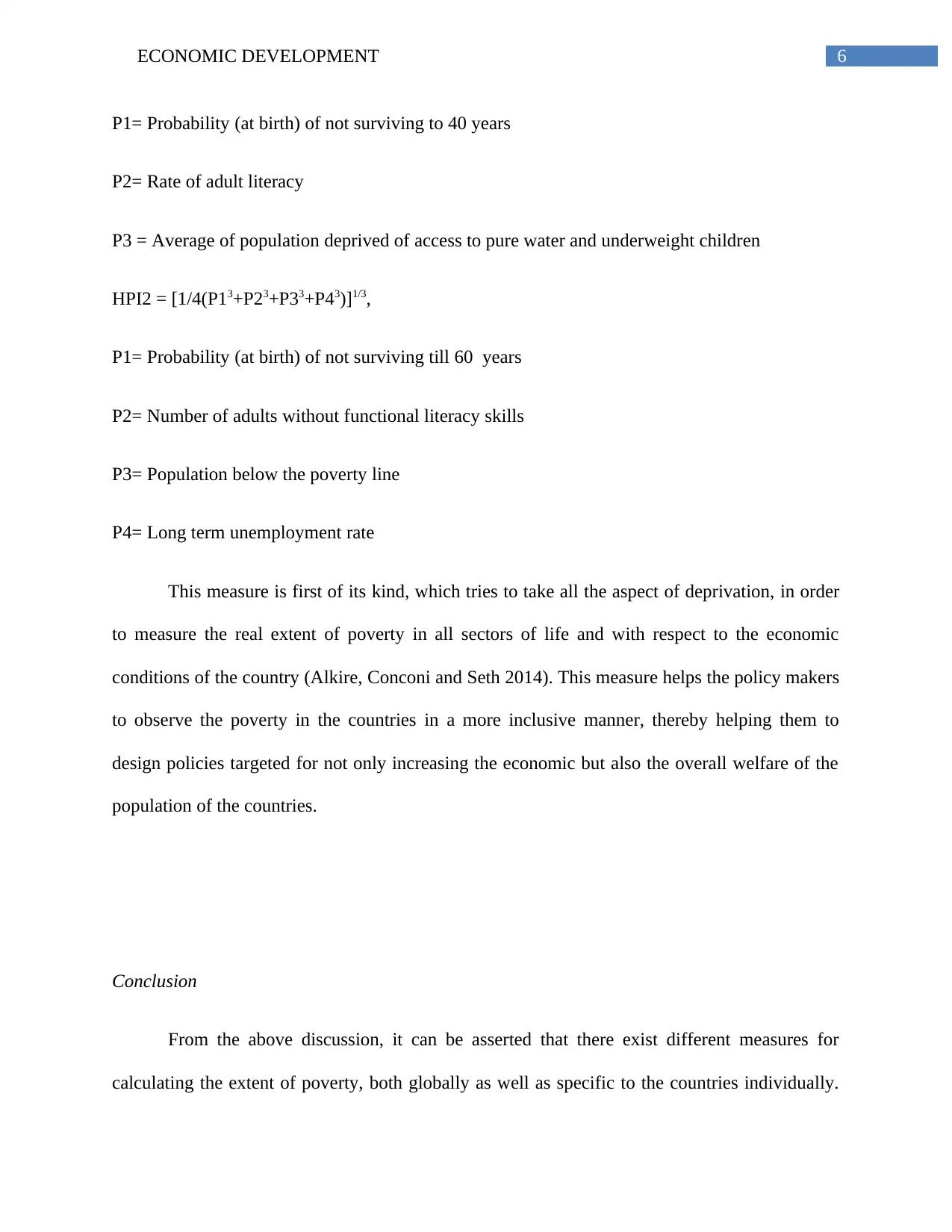
6ECONOMIC DEVELOPMENT
P1= Probability (at birth) of not surviving to 40 years
P2= Rate of adult literacy
P3 = Average of population deprived of access to pure water and underweight children
HPI2 = [1/4(P13+P23+P33+P43)]1/3,
P1= Probability (at birth) of not surviving till 60 years
P2= Number of adults without functional literacy skills
P3= Population below the poverty line
P4= Long term unemployment rate
This measure is first of its kind, which tries to take all the aspect of deprivation, in order
to measure the real extent of poverty in all sectors of life and with respect to the economic
conditions of the country (Alkire, Conconi and Seth 2014). This measure helps the policy makers
to observe the poverty in the countries in a more inclusive manner, thereby helping them to
design policies targeted for not only increasing the economic but also the overall welfare of the
population of the countries.
Conclusion
From the above discussion, it can be asserted that there exist different measures for
calculating the extent of poverty, both globally as well as specific to the countries individually.
P1= Probability (at birth) of not surviving to 40 years
P2= Rate of adult literacy
P3 = Average of population deprived of access to pure water and underweight children
HPI2 = [1/4(P13+P23+P33+P43)]1/3,
P1= Probability (at birth) of not surviving till 60 years
P2= Number of adults without functional literacy skills
P3= Population below the poverty line
P4= Long term unemployment rate
This measure is first of its kind, which tries to take all the aspect of deprivation, in order
to measure the real extent of poverty in all sectors of life and with respect to the economic
conditions of the country (Alkire, Conconi and Seth 2014). This measure helps the policy makers
to observe the poverty in the countries in a more inclusive manner, thereby helping them to
design policies targeted for not only increasing the economic but also the overall welfare of the
population of the countries.
Conclusion
From the above discussion, it can be asserted that there exist different measures for
calculating the extent of poverty, both globally as well as specific to the countries individually.
Paraphrase This Document
Need a fresh take? Get an instant paraphrase of this document with our AI Paraphraser
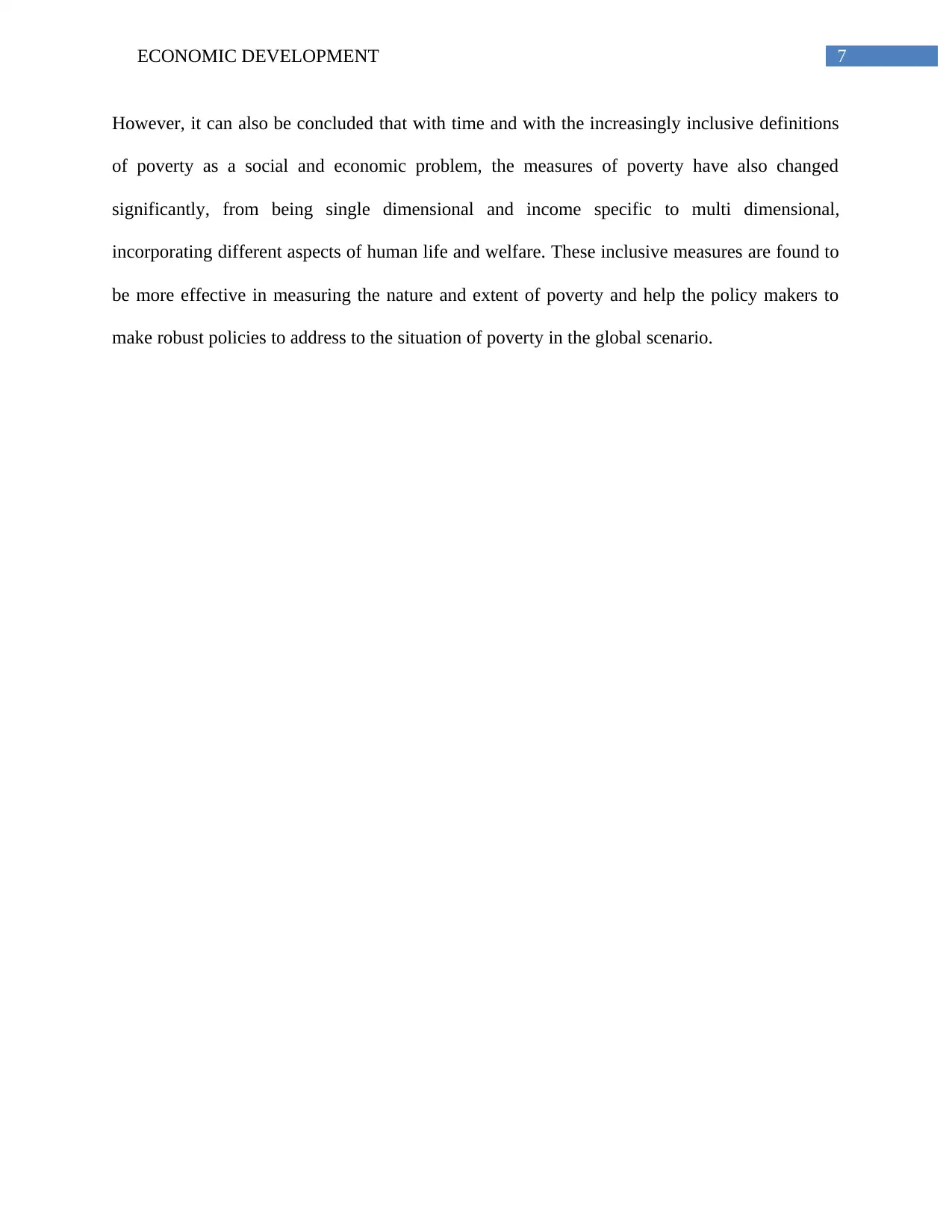
7ECONOMIC DEVELOPMENT
However, it can also be concluded that with time and with the increasingly inclusive definitions
of poverty as a social and economic problem, the measures of poverty have also changed
significantly, from being single dimensional and income specific to multi dimensional,
incorporating different aspects of human life and welfare. These inclusive measures are found to
be more effective in measuring the nature and extent of poverty and help the policy makers to
make robust policies to address to the situation of poverty in the global scenario.
However, it can also be concluded that with time and with the increasingly inclusive definitions
of poverty as a social and economic problem, the measures of poverty have also changed
significantly, from being single dimensional and income specific to multi dimensional,
incorporating different aspects of human life and welfare. These inclusive measures are found to
be more effective in measuring the nature and extent of poverty and help the policy makers to
make robust policies to address to the situation of poverty in the global scenario.
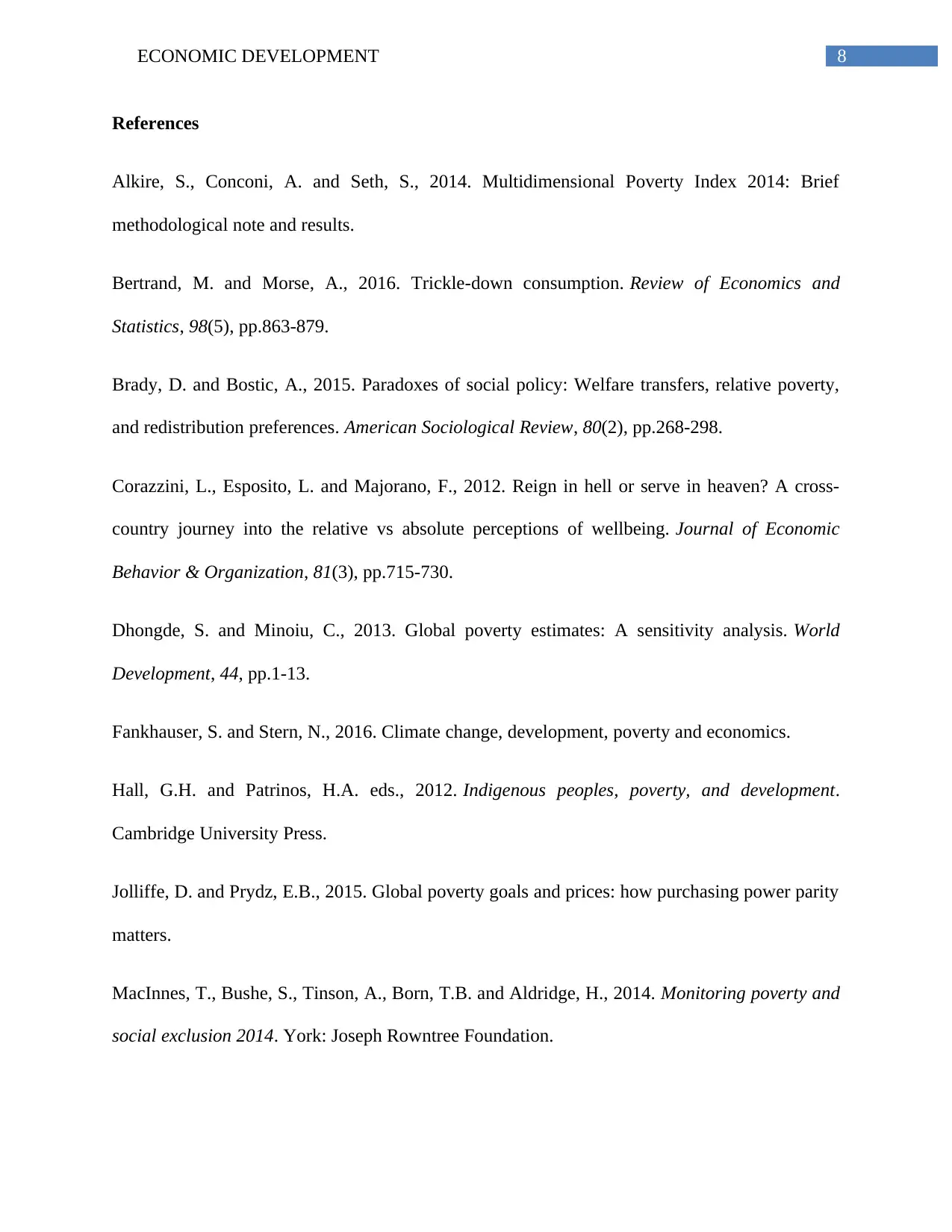
8ECONOMIC DEVELOPMENT
References
Alkire, S., Conconi, A. and Seth, S., 2014. Multidimensional Poverty Index 2014: Brief
methodological note and results.
Bertrand, M. and Morse, A., 2016. Trickle-down consumption. Review of Economics and
Statistics, 98(5), pp.863-879.
Brady, D. and Bostic, A., 2015. Paradoxes of social policy: Welfare transfers, relative poverty,
and redistribution preferences. American Sociological Review, 80(2), pp.268-298.
Corazzini, L., Esposito, L. and Majorano, F., 2012. Reign in hell or serve in heaven? A cross-
country journey into the relative vs absolute perceptions of wellbeing. Journal of Economic
Behavior & Organization, 81(3), pp.715-730.
Dhongde, S. and Minoiu, C., 2013. Global poverty estimates: A sensitivity analysis. World
Development, 44, pp.1-13.
Fankhauser, S. and Stern, N., 2016. Climate change, development, poverty and economics.
Hall, G.H. and Patrinos, H.A. eds., 2012. Indigenous peoples, poverty, and development.
Cambridge University Press.
Jolliffe, D. and Prydz, E.B., 2015. Global poverty goals and prices: how purchasing power parity
matters.
MacInnes, T., Bushe, S., Tinson, A., Born, T.B. and Aldridge, H., 2014. Monitoring poverty and
social exclusion 2014. York: Joseph Rowntree Foundation.
References
Alkire, S., Conconi, A. and Seth, S., 2014. Multidimensional Poverty Index 2014: Brief
methodological note and results.
Bertrand, M. and Morse, A., 2016. Trickle-down consumption. Review of Economics and
Statistics, 98(5), pp.863-879.
Brady, D. and Bostic, A., 2015. Paradoxes of social policy: Welfare transfers, relative poverty,
and redistribution preferences. American Sociological Review, 80(2), pp.268-298.
Corazzini, L., Esposito, L. and Majorano, F., 2012. Reign in hell or serve in heaven? A cross-
country journey into the relative vs absolute perceptions of wellbeing. Journal of Economic
Behavior & Organization, 81(3), pp.715-730.
Dhongde, S. and Minoiu, C., 2013. Global poverty estimates: A sensitivity analysis. World
Development, 44, pp.1-13.
Fankhauser, S. and Stern, N., 2016. Climate change, development, poverty and economics.
Hall, G.H. and Patrinos, H.A. eds., 2012. Indigenous peoples, poverty, and development.
Cambridge University Press.
Jolliffe, D. and Prydz, E.B., 2015. Global poverty goals and prices: how purchasing power parity
matters.
MacInnes, T., Bushe, S., Tinson, A., Born, T.B. and Aldridge, H., 2014. Monitoring poverty and
social exclusion 2014. York: Joseph Rowntree Foundation.
⊘ This is a preview!⊘
Do you want full access?
Subscribe today to unlock all pages.

Trusted by 1+ million students worldwide
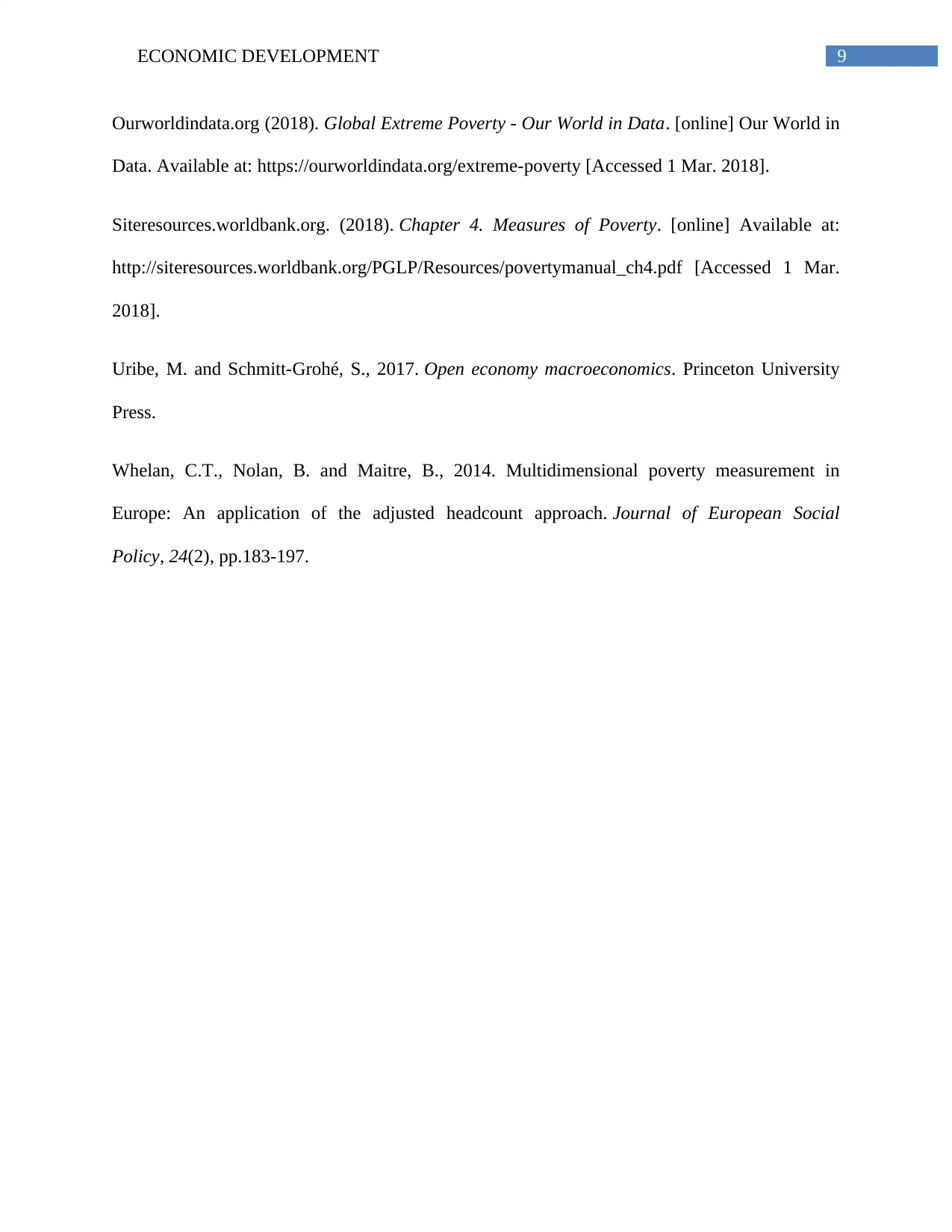
9ECONOMIC DEVELOPMENT
Ourworldindata.org (2018). Global Extreme Poverty - Our World in Data. [online] Our World in
Data. Available at: https://ourworldindata.org/extreme-poverty [Accessed 1 Mar. 2018].
Siteresources.worldbank.org. (2018). Chapter 4. Measures of Poverty. [online] Available at:
http://siteresources.worldbank.org/PGLP/Resources/povertymanual_ch4.pdf [Accessed 1 Mar.
2018].
Uribe, M. and Schmitt-Grohé, S., 2017. Open economy macroeconomics. Princeton University
Press.
Whelan, C.T., Nolan, B. and Maitre, B., 2014. Multidimensional poverty measurement in
Europe: An application of the adjusted headcount approach. Journal of European Social
Policy, 24(2), pp.183-197.
Ourworldindata.org (2018). Global Extreme Poverty - Our World in Data. [online] Our World in
Data. Available at: https://ourworldindata.org/extreme-poverty [Accessed 1 Mar. 2018].
Siteresources.worldbank.org. (2018). Chapter 4. Measures of Poverty. [online] Available at:
http://siteresources.worldbank.org/PGLP/Resources/povertymanual_ch4.pdf [Accessed 1 Mar.
2018].
Uribe, M. and Schmitt-Grohé, S., 2017. Open economy macroeconomics. Princeton University
Press.
Whelan, C.T., Nolan, B. and Maitre, B., 2014. Multidimensional poverty measurement in
Europe: An application of the adjusted headcount approach. Journal of European Social
Policy, 24(2), pp.183-197.
1 out of 10
Related Documents
Your All-in-One AI-Powered Toolkit for Academic Success.
+13062052269
info@desklib.com
Available 24*7 on WhatsApp / Email
![[object Object]](/_next/static/media/star-bottom.7253800d.svg)
Unlock your academic potential
Copyright © 2020–2025 A2Z Services. All Rights Reserved. Developed and managed by ZUCOL.





